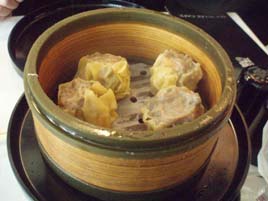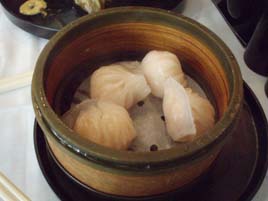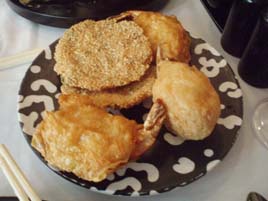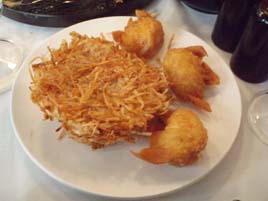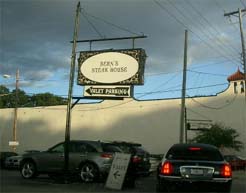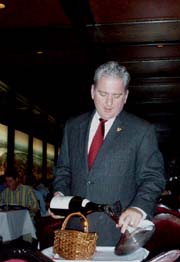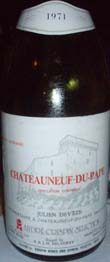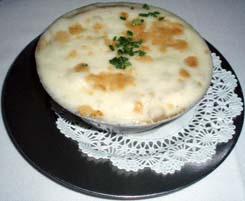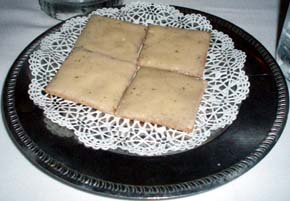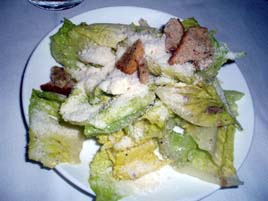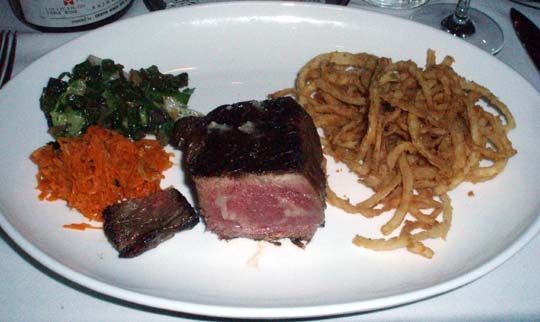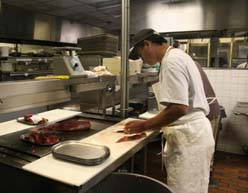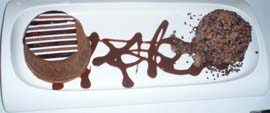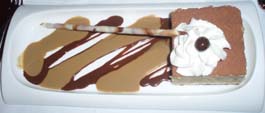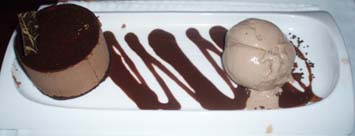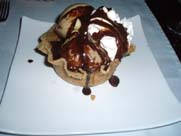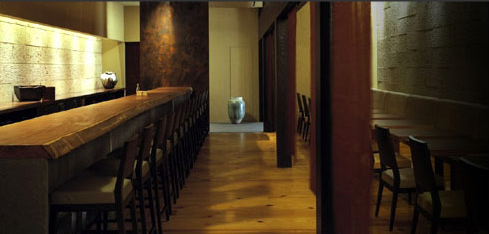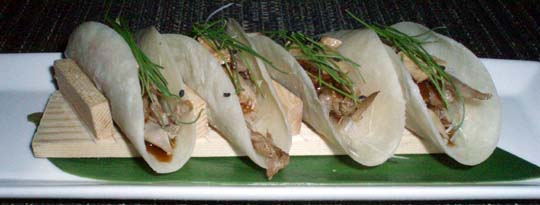
Note: The upstairs dining room at Country has closed, to be replaced around October 1 March 2009 with Country Steak. The downstairs Café at Country remains open.
Update: Forget Country Steak. Millesime, under chef Laurent Manrique, opened here in fall 2010.
*
Country is one of our favorite special-occasion restaurants. It may not be the best of those restaurants, but we adore the luxurious, spacious, old-school dining room, the first-class service, and food that usually exceeds our expectations.
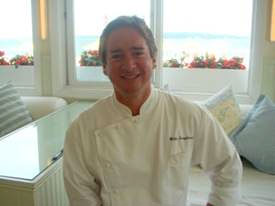
The new chef: Willis Loughhead [Country/Grub Street]We paid our fourth visit to Country on Saturday to check out the menu by Willis Loughhead, Country’s new chef. Loughhead, who made his reputation in Miami, arrived here without much of a publicity footprint. He quickly set about rectifying it.
We’re doing everything differently now,” he told Grub Street. “We’re breaking down whole animals, making our own charcuterie… And now that the Greenmarket is about to explode, you’re going to see so much from us based on that. It’s going to be very market-driven. Right now, I’m waiting for ramps, for instance. Just wait till they come in.”
Earlier this week, Gothamist had a “nose-to-tail” piece, with a photo of lamb and pig carcasses hanging on meat hooks:
Hanging in the wine cellar at Country’s Dining Room are, from left to right, lamb pancetta, pork pancetta, house-cured pigs’s leg prosciutto style, house-cured pig’s leg Serrano-style, Bresaola-style beef tenderloin and lastly imported Serrano with hoof.
“It’s not something you’re going to do unless you buy the whole animal,” Loughhead says of making charcuterie. As for the nose-to-tail aspect, the only folks who seem to be freaked out are the hotel staff: “The room service people complain when there’s a big pig or lamb’s head outside there office.”
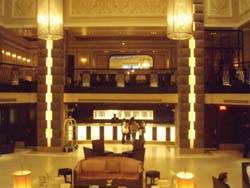 One eGullet poster proclaimed the charcuterie in the Café at Country, the casual sister to the main dining room, was as good as or better than the offerings at Bar Boulud and Benoit—tall praise indeed if it is true.
One eGullet poster proclaimed the charcuterie in the Café at Country, the casual sister to the main dining room, was as good as or better than the offerings at Bar Boulud and Benoit—tall praise indeed if it is true.
But Loughhead is taking his sweet time about reforming the flagship restaurant. We found a new menu that still needs a lot of work, and that falls short of the rapture that a restaurant on Country’s level ought to deliver. There are just four appetizers, four mid-courses, five entrées, and four desserts—a perplexingly low total.
The appetizers and mid-courses were uniformly good, but except for rhubarb in one dish, we didn’t see the “haute barnyard” influence that Loughhead has been selling to bloggers and publicists.

The entrées on a recent menu at Country
The entrées were shockingly unimaginative, in addition to being over-cooked and tough. If Loughhead is breaking down whole animals, then why are most of the entrées just the standard rectangle of protein with a medley of vegetables? And why are they all cooked the same way? Every one we asked about, the server said: pan-seared, then roasted. The menu style shown above is reflected throughout: a main ingredient in capital letters (“PORK”), with little indication of what is done with it.
The menu at Country is priced at $75 for three courses, $89 for four courses, or $135 for the chef’s tasting menu. The middle option, which we had, is probably the best one, given that an extra savory course is only $14 extra. All of the menus at Country include canapés, an amuse-bouche, a plate cleanser, petits-fours, and one of the best bread services in town. We also received a complimentary glass of champagne to start. I am not sure if that is the norm, or if it was because the staff recognized us.
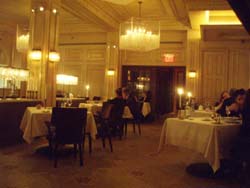 Despite my dismay at Loughhead’s half-hearted re-boot of the menu and the disappointing entrées, there are still many reasons to love Country. It sports one of the loveliest dining rooms in town, elegant service, and candle-lit tables widely spread out. There is hardly a better place to enjoy a leisurely, romantic meal. And given the number of excellent courses served for $89, I am almost ready to forgive the flawed entrées. Well, almost.
Despite my dismay at Loughhead’s half-hearted re-boot of the menu and the disappointing entrées, there are still many reasons to love Country. It sports one of the loveliest dining rooms in town, elegant service, and candle-lit tables widely spread out. There is hardly a better place to enjoy a leisurely, romantic meal. And given the number of excellent courses served for $89, I am almost ready to forgive the flawed entrées. Well, almost.
The restaurant was not full, and our 8:00 p.m. table, nestled in a quiet alcove, was ours for the evening. Two dainty canapés arrived quickly. I neglected to photograph them, but one was a cube of seared tuna, the other a small, deep-fried risotto ball.
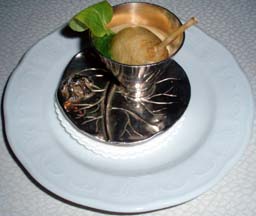
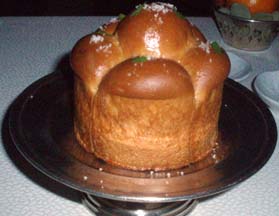
The amuse-bouche was a frog leg in a garlic cream and watercress purée. The bread service, I am glad to say, has not changed: a large, warm Parker House roll. When we were about 2/3rds done with it, the staff brought another one, which we most reluctantly had to leave untouched.


Four our first course, I had the White & Green Asparagus with Serrano ham, mustard vinaigrette and fried quail eggs. My girlfriend raved about the Sea Trout Tartare, with barbequed eel, yuzu and cucumber.
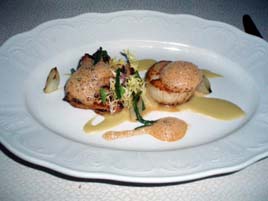

I can’t identify the foam that came atop a grilled sea scallop; pork belly on the left-hand side of the plate didn’t make quite the impression that it normally does. But my girlfriend’s seafood risotto was the knockout dish of the evening. It was chock-full of chunky lobster, squid, cockles and dorade.

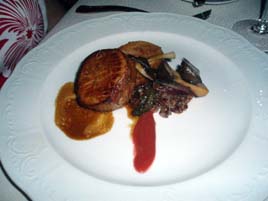
Our entrées were “DUCK” (left) and “PORK” (right). I loved the sear on the duck, but it was a bit tough; but that was nothing compared to my girlfriend’s pork, which was dry and even tougher. “They were probably cooked by the same heavy-handed guy at the meat station,” she suggested.
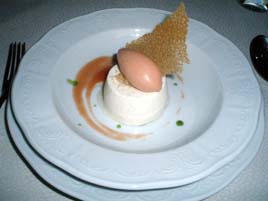
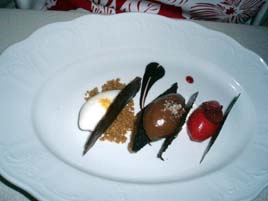
There clearly is a great talent in the pastry kitchen here. I neglected to photograph the palate cleanser, which was one of the most creative dishes we had: a lime granité with coconut foam, lemon pearls and sweet soda, served with a long spoon that doubled as a straw.
Both desserts were excellent: “YOGHURT” with guava, grapefruit and sesame (above, left) and “MILLE FEUILLE” (above, right) with raspberry, gianduja and fromage blanc.
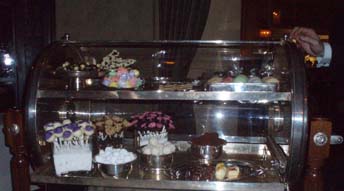

Last, came perhaps the best petits-fours cart we’ve seen since Alain Ducasse.
 William Rhodes is now in charge of the wine program. The bottles are generally expensive, as one would expect, but Rhodes is stocking whites as low as $40 and reds as low as $50. Throughout the list, there are wines touted as “Sommelier Selections,” and they aren’t just the expensive ones. Based on our 2005 St. Joseph, Rhodes’s instincts can be trusted.
William Rhodes is now in charge of the wine program. The bottles are generally expensive, as one would expect, but Rhodes is stocking whites as low as $40 and reds as low as $50. Throughout the list, there are wines touted as “Sommelier Selections,” and they aren’t just the expensive ones. Based on our 2005 St. Joseph, Rhodes’s instincts can be trusted.
There were minor service hiccups, none of which seriously undermined our evening, but which should not happen at a restaurant at this level. All were probably attributable to a server who, though eager to please, was error-prone.
Though I’d ordered one of the sommelier-recommended reds, a white wine was brought to our table. It’s a rather peculiar foul-up to bring a bottle many pages away from the one you picked. To his credit, the server admitted the error, and the restaurant had to eat the mistake.
We were given plenty of time to order, but we actually had to ask for a wine list. During the meal, runners at least twice were mixed up about which dish was mine, and which was my girlfriend’s.
*
If I had never before dined at Country, I would award 2½ stars. That is my usual rating for a restaurant that very clearly has the potential for three stars, but hasn’t quite lived up to them. Given our long history with Country, we assume that we caught the dining room in transition. Chef Loughhead has a vigorous publicity machine behind him. Now, he needs to deliver the goods.
Though I am coming down a bit hard on Country, it’s because we know from experience that transcendent meals are possible here. By and large, this was a transcendent meal, but for the entrées. However, it is a significant problem when both meat dishes fall as flat as they did here.
Diners lured by the press coverage are going to have high hopes for a restaurant with such a high price tag. We will be back, as the wonderful dining room and luxurious service will always have a tug on our affections. But for the new clientele that Country is trying to attract, there might not be a second chance to make a strong first impression.
Country (90 Madison Avenue at 29th Street, Flatiron District)
Food: ***
Service: ***
Ambiance: ****
Overall: ***
 Saturday, May 17, 2008 at 07:32AM
Saturday, May 17, 2008 at 07:32AM 
 Shortly after the 1985 makeover, the front dining room was converted into a separate Dim Sum-themed restaurant called Shun Lee Cafe. The main restaurant and the cafe are separately reservable on OpenTable, but they share the kitchen and restroom areas.
Shortly after the 1985 makeover, the front dining room was converted into a separate Dim Sum-themed restaurant called Shun Lee Cafe. The main restaurant and the cafe are separately reservable on OpenTable, but they share the kitchen and restroom areas. Dim Sum comes on a cart, which a server wheels around the restaurant. There are only a few items at a time on the cart. This keeps the food fresh, but you don’t really know what’s coming next. The server just tells you what she has; either you want some, or you wait until next time the cart comes around. After she serves you, she scribbles on the back of a card. The more scribbles at the end of the meal, the more you pay.
Dim Sum comes on a cart, which a server wheels around the restaurant. There are only a few items at a time on the cart. This keeps the food fresh, but you don’t really know what’s coming next. The server just tells you what she has; either you want some, or you wait until next time the cart comes around. After she serves you, she scribbles on the back of a card. The more scribbles at the end of the meal, the more you pay.